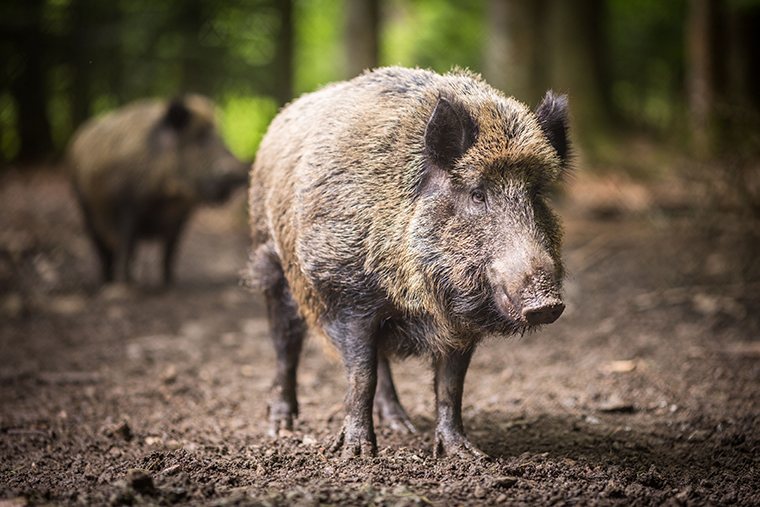
Ask any hunter to recite a list of wild mammals residing in Ontario and the odds are good wild pigs won’t be mentioned. Yet, when Ontario Federation of Anglers and Hunters (OFAH) biologist Keith Munro placed an online survey regarding wild pig sightings last year, he received 10 reports almost immediately.
These were not old sightings, either. Almost all of the respondents described recent encounters with solitary or small groups of wild pigs. Nor were they concentrated in one region. The sightings spanned the province from Tobermory to Belleville, and Munro deemed each credible due to strong photographic evidence or specific descriptions. Since then, Munro says he has been able to confirm several more sightings, including a big group in the Parry Sound area.
“Wherever I look, I tend to find evidence,” he said.
Troubling numbers
In his research, Munro consulted with Dr. Ryan Brook, an associate professor at the University of Saskatchewan, who is one of Canada’s leading experts on wild pigs. During one of their conversations, Brook said something that left Munro even more troubled by the numbers reported.
“Dr. Brook said passive data collection, such as those responses gathered from our survey, tends to hear about less than 5% of the wild pigs out there,” said Munro.
This makes sense since wild boars tend to be elusive, nocturnal, and spend most of their time in tangled places.
If that’s the case, it’s conceivable that as many as 400 wild pigs might currently reside in the province. And while those numbers do not suggest Ontario is overrun with them, the fact that even small groups exist within our borders is cause for concern. Wild pig populations, left unchecked, tend to increase their numbers and range rapidly, and that is never good news for native flora and fauna.
Profile of a wild pig
What is a wild pig?
When most hunters hear the words wild pig, they envision Eurasian wild boars, a legendary game species from Europe and Asia. In North America, however, a wild pig is not so easily defined.
“Most are a mix of escaped Eurasian wild boars and escaped domestic pigs,” said Brook.
That’s why he refers to them as wild pigs.
“The term wild pigs covers the gamut,” he said. “That means a wild pig, for me, is anything that looks like a pig that is outside of the fence.”
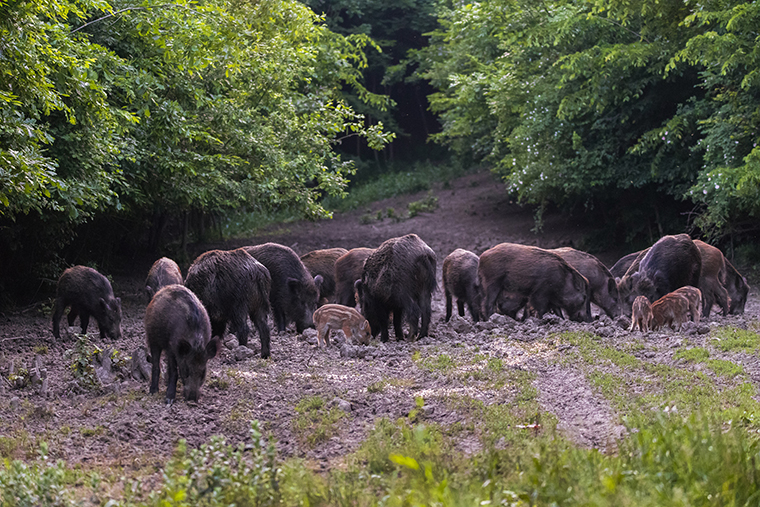
Introducing super pig
That’s a reasonable way to look at it, since domestic ancestry does not make a pig any less destructive, especially when it has gone feral. In fact, Brook says the hybridization of the domestic feral pig and Eurasian wild boar creates super-pigs that tend to be much bigger and longer. Most weigh between 50 and 90 kilograms (110 to 200 pounds) but can approach 200 kilograms (440 pounds) or, on occasion, even more. They also have larger litters and they have them more frequently.
Wild pigs have been an issue in Canada since the 1980s when Agriculture Canada enacted a livestock diversification program that allowed importation. Brook says most were brought in from Europe or Asia for meat farms or penned shoot operations. Some issues we face today are the result of direct releases back then.
Currently, every Canadian province outside of the Atlantic provinces has populations of wild pigs, with Saskatchewan having numbers that Brook says will make eradication almost impossible, without a huge investment in money to fund a coordinated government effort. In the U.S., they can be found in almost 40 states and tend to be more common the farther south you go.
An ecological train wreck
“Once pigs are outside the fence, they all have the potential to be serious problems,” Munro said.
In farm country, wild pigs can cause extensive crop damage. They are a multi-billion dollar problem to the U.S. agricultural industry, says Brook, since they also love canola, barley, and wheat, and will take significant risks to get into good quality corn. They are smart and secretive enough to eat swaths of corn inside the outer edges of the field so that the crop looks untouched from the outside.
Wild pigs can also make crops unfit for market. In 2006, a deadly outbreak of E. coli in spinach grown in California killed three people and made almost 200 sick. That incident was linked to the manure of wild pigs that were raiding the fields.
In wild places, they are ravenous and opportunistic omnivores that threaten flora and fauna. They will root for underground food and break up soil until only patches of mud are left. They will eat many native species, destroy sensitive ecological areas, make life even more difficult for species at risk, and spread invasive plants by transferring seeds in their excrement.
Wild pigs are also very aggressive and will compete with larger animals for food resources, often moving them off the source. Essentially, they alter the ecological landscape, and not for the better.
The ultimate survivor
As if changing the environment is not bad enough, Brook says pigs are tougher and more adaptable than most of the animals they compete with.

“Pigs can survive under extreme conditions as long as there is food to support them. Their diverse diet also helps. Climate change might be encouraging their range expansion, too, since milder conditions allow more access to food,” said Brook.
Essentially, if food is available, Brook notes, they can thrive almost anywhere. Extreme cold, unless it is without snow, is not a limiting factor. Though they tend to be less active in winter, their longer legs, coarse fur, and social behaviour help them move efficiently and survive in deep snow. He says Bergmann’s Rule means that the further north they live, the bigger they get on average.

In winter in Saskatchewan, Brook has observed that they utilize cattails to make communal nests, dubbed as “pigloos.” Throughout the rest of the year, they tend to spend most of their time in the “nastiest cover” in the area.
“Most sightings are tied to agriculture,” he said, “but we see sightings in boreal forests, too. Basically, anywhere you find whitetail deer, you could conceivably see pigs.”
Living high off the hog
Though they are mostly foragers of plants and nuts, they also consume the eggs of any ground-nesting bird or waterfowl they encounter and eat everything from frogs and other amphibians to medium-size animals and deer fawns. Rotting carcasses are huge attractants to them.
Sows and their young travel in groups called sounders. These generally comprise six to 14 animals, including one matriarchal female, her daughters, granddaughters, and often great granddaughters as well as their piglets.
Mature male wild pigs tend to be solitary, continually looking for sows to breed. Like Eurasian wild boars, wild pigs tend to be ill-tempered and aggressive, with razor-sharp tusks to back it up. A provoked wild pig can be a dangerous thing.
Their reproductive rate, which is the highest of any ungulate, also makes them hard to eradicate. Brook says they breed twice a year on average, with a gestation period of three months, three weeks, and three days. A typical litter has six to 13 piglets. They mature sexually at five to six months, which means that one pregnant sow can be the source of 100 offspring in just two years.
They are long-lived; having been known to reach 25 years.
Most predator-inflicted mortality occurs in the first year of their lives, as very few animals will attempt to predate on a healthy, fully grown wild pig. Bears, coyotes, and wolves have been known to take young piglets, but even that’s not an easy task. The big sows in the sounder are determined and capable defenders of their offspring.
Sport hunting wrong approach
Due to their potential for extensive ecological and agricultural damage, most jurisdictions choose to eradicate wild pig populations before they take hold. And while some hunters might be excited by the prospect of having another animal to hunt year-round without limits, Brook advocates that controlling pig numbers though sport hunting is the wrong approach.
“Sport hunting helps them survive,” he said. “It breaks up the sounders and educates them. If you want more wild pigs, have a hunting season.”
Brook says wild pigs are extremely smart and will go completely nocturnal when faced with hunting pressure. When sounders break up due to hunting, you suddenly have subgroups in several new areas rather than just in the old one — and each group will be more cautious and bounce back in numbers in a short time.
“You could kill off 70% of a wild pig population each year and still have a larger population the next year,” he said.
He believes that total eradication of pigs from an area requires buy-in from relevant government agencies. This means lots of funding, landowner cooperation, and trained hunt teams.
“It needs to be a coordinated effort with the objective of whole sounder removal,” he said.
This often requires aircraft, trained, experienced hunt teams, and ground traps. Brook cautions that anything short of whole sounder removal does nothing to affect long-term populations.
“If there are 12 pigs in a sounder and you kill 10, that’s a failure,” Brook cautioned. “It’s merely a temporary result, like cutting the grass.”
What’s worked
He says successful efforts include coordinated practices that begin with finding wild pigs by utilizing aircraft and sometimes shooting them from helicopters — though he does not advocate the latter.
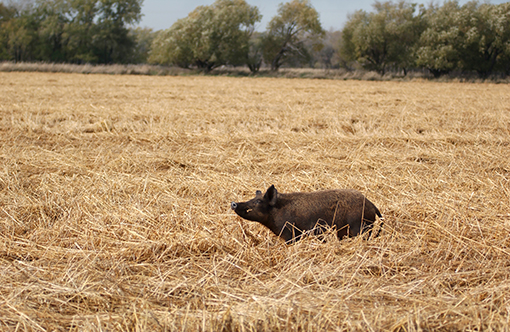
In many cases, heat-seeking and night-vision devices help with the location of sounders, as do local reports, and trail-camera footage. Net guns have also been used with success. Nitrate-based poisons are now used in Australia and are being considered in some parts of the U.S. The issue with poison is that it needs to be placed in ways that prevent other species from accessing it.
In Europe, “Judas pigs” are also used on occasion. These are domestic boars that have been sterilized and fitted with GPS collars. They are then freed in areas where wild pigs have been reported and monitored until their movements indicate that they have found a sounder.
“The quickest way to find pigs is with another pig,” Brook said.
Public awareness regarding wild pigs is also essential, so landowners and others report sightings, and appropriate steps can be taken.
Fast, aggressive efforts
Only four American states have had successful eradication programs and each of those addressed the issue early, Brook said.
“Those efforts have been fast and aggressive.”
What if you see one?
Currently, in Ontario wild pigs are viewed as escaped animals that should be removed from the landscape by the owner or, failing that, by hunters. This addresses the fact that Ontario’s farmers are allowed to raise wild boars as alternate livestock for meat, and that, sometimes, livestock escapes its enclosures.
Ministry of Natural Resources and Forestry (MNRF) Enforcement Specialist David Critchlow says wild boars are considered to be small game for hunting purposes in Ontario. As such, a small game licence is required to hunt them. There is no closed season and no limit.
That doesn’t mean you should immediately shoot them.
“Most wild boars in Ontario are the property of someone and the animal being seen may have escaped from that person. Anyone who has a wild boar that has been released or has escaped must inform the MNRF and recapture or kill the animal as soon as practical.
If people see wild boars on the landscape, MNRF would like them to call the local district office to report the sightings, including location and time of sighting, numbers of animals, whether adults or young are present, and any other information that may be of importance. Where ownership of wild boars on the landscape cannot be ascertained, the animals may be hunted.”
For more regarding MNRF policies on wild boar or how to report sightings, click here.
Fork in the road
The good news is the OFAH and MNRF are aligned on wild pigs, in that neither wants them in Ontario. Munro points to the Federation’s broad policy against boar farming since the early 1990s. Also, OFAH opposition to hunting animals in captivity contributed to a provincial ban on this activity.
The MNRF’s Fish and Wildlife Conservation Act prohibits the release of wild boar and requires farmers to keep them securely within an enclosure, report escapes immediately, and make efforts to capture or kill the animal. Farmers are also legally responsible for costs associated with recovery.
At press time, the OFAH was working on crafting a specific policy and following up on more wild pig sightings in order to have a better understanding of their numbers and to assess their potential impact in the province.
According to Brook, Ontario has a window of opportunity with regard to wild pigs.
“You still have small enough numbers that it will be relatively easy to eradicate them,” he said. “It’s far better to deal with the problem at this stage. All you need is to do is take this seriously and work with the stakeholders. I liken it to having a fire in your home. If, you get on it quickly and aggressively you can stop it.”
Clearly, there is no other choice.
Originally published in the June 2019 issue of Ontario OUT of DOORS.


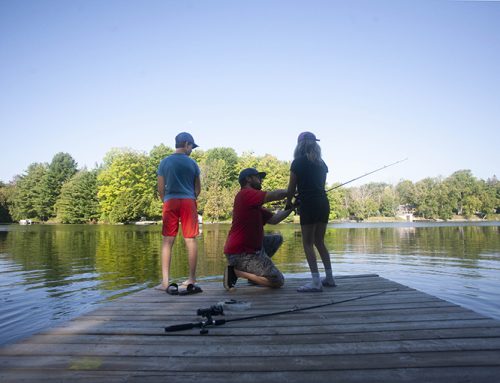
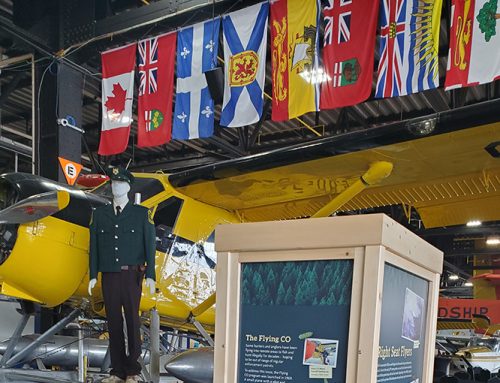
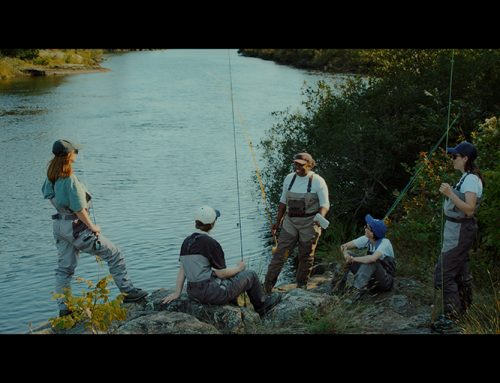
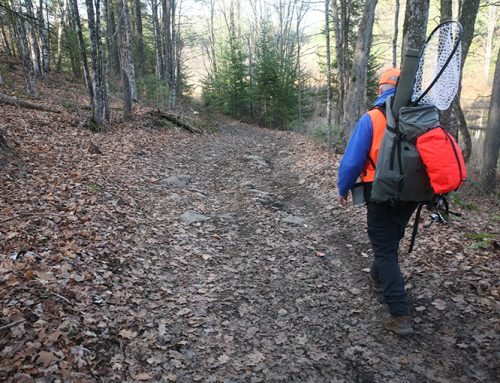
Where have they been sighted ? It should be posted so hunters can go after them.
That’s enough to get a guy to buy a new smoker.
The MNRF gave this additional comment on one of OOD’s social platforms:
At this time, hunting wild pigs in Ontario is not recommended.
Research and management from other jurisdictions show that hunting is ineffective at eliminating invasive wild pigs and can accelerate the spread of their populations. Wild pigs that are exposed to hunting disperse into new areas and learn quickly to avoid humans, which can make future efforts to eliminate invasive wild pigs in the province harder.
The ministry continues to urge the public to report wild pig sightings. Reported sightings play a critical role in understanding the locations and number of wild pigs in the province and will inform Ontario’s research and management.
Sightings can be emailed to [email protected] or submitted to the iNaturalist Ontario Wild Pig Reporting webpage.
May 26th 9 p.m. Just saw a wild piglet walking through the back yard in Collingwod Ontario
Hi OFAH
As a farmer who used to raise pigs when i was a boy and a Hunter i agree with much of the above statements.
The area that i see that is and will be the problem is the Hunter / Landowner / Farmer having to Deal with All levels of Government on this issue especially if the Local Conservation Authorities get involved as per most Farmers and Landowners will Want to have Nothing to do with Any Of The Local Conservation Authorities for many good reasons because of their ” Wanting Total Control / Authority of Everything Within There Zone ”
( personally if i saw a wild pig on property with in my control even though i agree with what you say above, i would not trust calling the MNR or Local Police because of lack of trust in both of them as well as that they also then bring in the local Conservation Authorities who in my opinion are selfish self serving idiots )
Personally i don’t think i will be alone in my opinion either because of the huge disconnect between Rural & Urbans because of the vast Discrimination by All levels of Government towards Rural Land Owners
Establishing Trust with the Landowners Will Be the Biggest Hurdle
The other fact that will be an obvious issue is the fact as you said above that if a Farmer happened to have a Pig get loose, even though it may be ethical for him to deal with it and or report it.
But because of the fact that once the farmer has reported a escaped pig to be held responsible for any damages or recapture efforts, do you honestly think that a farmer in his right mind will want to report the loss ??
All reporting it will do is give the various Authorities to have there Invoice book out ready to Write Fines Instead of what the Main Objective should be to Capture the Pig For The Greater Good.
I think the OFAH Should Be Educating Hunters on If & When Wild Pig / Pigs Are Spotted, How To Pick What Pig To Shoot 1st, What Caliber is Best To Use, Where to Aim for for the best chance at a Kill as per Pigs are a hard animal to kill
( i will relate this to a story a old butcher told me about a pig barn fire in Burlington many years ago where he happened to come across, with police on the scene trying to kill the pigs and having no idea how to humanly kill a pig with single shots )
Sincerely
Bill Bousfield – Burlington